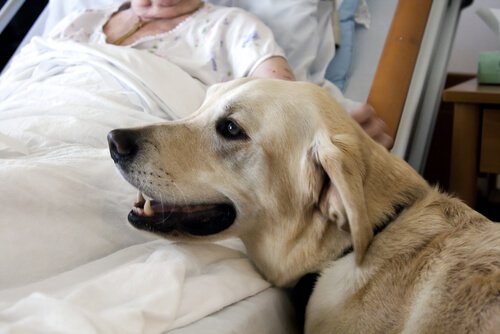The Special Ability of Epilepsy Detection Dogs


Written and verified by the lawyer Francisco María García
Epilepsy detection dogs have the special ability to detect epileptic seizures in the people around them. They can even sense the attacks before they actually take place.
Signs of epileptic seizures and epilepsy detection dogs
Using established signals,specially trained dogs can notify their owners of a seizure and take the necessary steps to avoid convulsions, and get timely appropriate attention.
But how do epilepsy detection dogs detect these changes in the person before they even experience an attack? Experts say that there are certain external signs they can detect, like smell, changes in tone of voice, and unusual behavior.

The dog does more than just detect that something isn’t right with his owner. After the seizures, the animal will help his owner recover from the confusion and disorientation he is experiencing. Don’t forget that a dog can be trained to perform certain tasks depending on the owner’s needs.
Coexistence between epileptic persons and epilepsy detection dogs
As you can see, your pet can play a fundamental role in the life of a person who suffers from epilepsy. However, we want to make it clear that having a dog means you have to change your entire lifestyle. You have to leave room for your dog in your daily life.
Daily coexistence means you have to take care of your pet. That means taking him for walks, training him, cleaning him, and always making sure he’s as healthy as possible. You’ll have to take him to the vet regularly, and make sure he has a good diet. Remember, all of this will affect the family budget considerably.
These responsibilities will last for 10-12 years, which is a dog’s average life span.
Dog training to prevent epileptic seizures
When it comes to dogs that can help prevent epileptic seizures, there are two different kinds. First, we have the ‘preventative dogs’, which have an innate ability to alert their owners of an imminent attack. On the other hand, there are ‘response dogs’, which know how to respond in the event of an attack.
Response dogs are trained to develop one or several specific and important skills; most of these are useful after the seizure has occurred. For example, they can press an alarm button, wake the person up, bring them a telephone, etc.
This type of training is very similar to that of dogs who are trained to assist people with physical disabilities. However, it is more adapted to the needs and peculiarities of those with epileptic tendencies.
Trained dogs’ attitude

If the dog has been well-trained and has spent a lot of time with his owner, the owner should start to notice if his dog does anything specific before an attack occurs. Ideally, he should keep these signals and behaviors in mind. That way, the owner will know the dog’s precise behavior before an attack.
Another good technique is to keep track of the time that passes between each seizure. That way, the owner can prepare himself in the best way possible, and this will help him avoid any injuries from falls.
Scientific tests
In different studies, experts have discovered that some dogs can detect future seizures up to 45 minutes before they actually occur. Dogs can reduce the risk by whining or barking to warn their owner. These actions are very useful.
The owner, or the person experiencing the epileptic seizure, will then know that he’s going to suffer from an attack. He can then make sure he is sitting down, or in a safe place, away from the stairs. That way, he can avoid falling or hurting himself when the attack comes.
So, the dog won’t just serve as an alarm. Instead, he’ll be next to, or even on top of, his owner when the attack occurs. This will keep him calmer, and will keep the owner’s body more stable. It also reduces the possibility of suffering falls or injuries.
Epilepsy detection dogs have the special ability to detect epileptic seizures in the people around them. They can even sense the attacks before they actually take place.
Signs of epileptic seizures and epilepsy detection dogs
Using established signals,specially trained dogs can notify their owners of a seizure and take the necessary steps to avoid convulsions, and get timely appropriate attention.
But how do epilepsy detection dogs detect these changes in the person before they even experience an attack? Experts say that there are certain external signs they can detect, like smell, changes in tone of voice, and unusual behavior.

The dog does more than just detect that something isn’t right with his owner. After the seizures, the animal will help his owner recover from the confusion and disorientation he is experiencing. Don’t forget that a dog can be trained to perform certain tasks depending on the owner’s needs.
Coexistence between epileptic persons and epilepsy detection dogs
As you can see, your pet can play a fundamental role in the life of a person who suffers from epilepsy. However, we want to make it clear that having a dog means you have to change your entire lifestyle. You have to leave room for your dog in your daily life.
Daily coexistence means you have to take care of your pet. That means taking him for walks, training him, cleaning him, and always making sure he’s as healthy as possible. You’ll have to take him to the vet regularly, and make sure he has a good diet. Remember, all of this will affect the family budget considerably.
These responsibilities will last for 10-12 years, which is a dog’s average life span.
Dog training to prevent epileptic seizures
When it comes to dogs that can help prevent epileptic seizures, there are two different kinds. First, we have the ‘preventative dogs’, which have an innate ability to alert their owners of an imminent attack. On the other hand, there are ‘response dogs’, which know how to respond in the event of an attack.
Response dogs are trained to develop one or several specific and important skills; most of these are useful after the seizure has occurred. For example, they can press an alarm button, wake the person up, bring them a telephone, etc.
This type of training is very similar to that of dogs who are trained to assist people with physical disabilities. However, it is more adapted to the needs and peculiarities of those with epileptic tendencies.
Trained dogs’ attitude

If the dog has been well-trained and has spent a lot of time with his owner, the owner should start to notice if his dog does anything specific before an attack occurs. Ideally, he should keep these signals and behaviors in mind. That way, the owner will know the dog’s precise behavior before an attack.
Another good technique is to keep track of the time that passes between each seizure. That way, the owner can prepare himself in the best way possible, and this will help him avoid any injuries from falls.
Scientific tests
In different studies, experts have discovered that some dogs can detect future seizures up to 45 minutes before they actually occur. Dogs can reduce the risk by whining or barking to warn their owner. These actions are very useful.
The owner, or the person experiencing the epileptic seizure, will then know that he’s going to suffer from an attack. He can then make sure he is sitting down, or in a safe place, away from the stairs. That way, he can avoid falling or hurting himself when the attack comes.
So, the dog won’t just serve as an alarm. Instead, he’ll be next to, or even on top of, his owner when the attack occurs. This will keep him calmer, and will keep the owner’s body more stable. It also reduces the possibility of suffering falls or injuries.
This text is provided for informational purposes only and does not replace consultation with a professional. If in doubt, consult your specialist.








